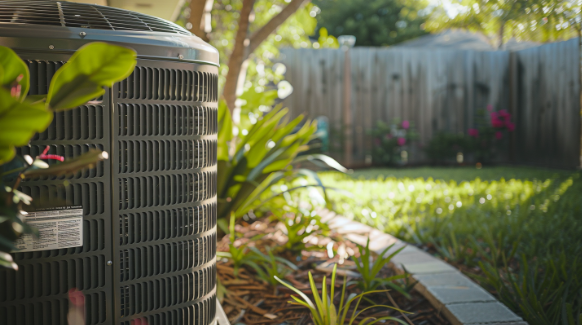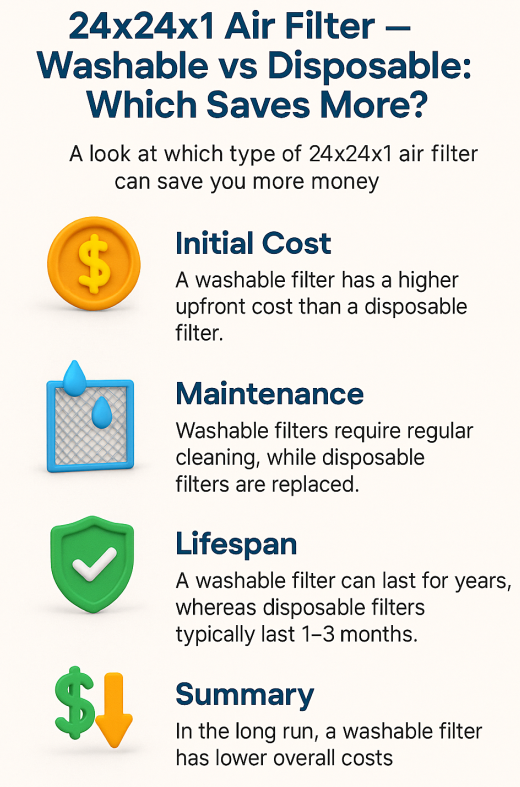24x24x1 Air Filter – Washable vs Disposable: Which Saves More?
Not sure if a washable or disposable 24x24x1 air filter will actually save you more? After building and testing millions of filters in the U.S. for over a decade, we’ve seen the hidden trade-offs firsthand. While washable filters may look like the cheaper option up front, we’ve found that they often lose effectiveness faster, require extra upkeep, and can leave behind particles that impact your family’s air quality and HVAC performance.
At Filterbuy, we’ve compared how each filter type performs across real homes, real systems, and real budgets. In this guide, we’ll share what we’ve learned about the true lifetime cost, convenience, and health impact of washable vs. disposable 24x24x1 filters—so you can make a confident choice backed by experience, not just assumptions.
Top Takeaways
Washable filters – Cheaper upfront, but lower performance, more maintenance, higher energy costs.
Disposable filters – Better at trapping fine particles, protecting HVAC systems, and saving money long-term.
MERV ratings matter –
MERV 8–11: Standard dust/debris.
MERV 13+: Allergies, smoke, fine pollutants.
Maintenance is key –
Disposables: Replace every 2–3 months.
Washables: Rinse monthly, dry fully.
Best choice for most homes – Disposable 24x24x1 filters = cleaner air, savings, convenience.
At first sight, a washable 24x24x1 air filter could be seen as the most money-saving option. Only one is bought, rinsed every month to be used again for years. However, the "savings" are often accompanied by invisible expenses based on our experience in producing and testing filters. Washable filters usually collect lower quantities of fine particles (such as dust, pollen, and pet dander) and require a very time-consuming cleaning process. If the cleaning has been neglected, they may even cause the growth of mold or obstruct the airflow, which in turn will increase your energy bills.
A disposable 24x24x1 filter, on the other hand, is less expensive per unit upfront but is meant to deliver steady performance. Higher-MERV disposable filters go deep inside the air and trap even the tiniest particles that washable ones fail to do, thus, the health of your family and the HVAC system is better protected. They also contribute to the system efficiency, which can result in energy and repair costs savings in the long run.
The Bottom Line
Washable filters may reduce purchase frequency but can compromise air quality and efficiency if not maintained perfectly.
Disposable filters provide reliable filtration and time savings, often proving more cost-effective when you factor in energy use, HVAC lifespan, and health benefits.
Our take: For most households, disposable 24x24x1 filters deliver the best balance of savings, convenience, and clean air protection.

“After building and testing millions of filters in U.S. homes, we’ve found that washable 24x24x1 filters often underperform over time. While they appear to save money upfront, their reduced particle capture and higher maintenance can drive up energy costs and strain HVAC systems. In contrast, high-quality disposable filters consistently protect both indoor air and equipment efficiency—making them the smarter long-term investment for most families.”
Case Study & Real-World Insights
When “Washable Savings” Backfire
A Florida homeowner used a washable 24x24x1 filter for 6 months.
Rinsed regularly, but fine dust and allergens still circulated.
HVAC system worked harder → energy bills up ~20%.
The air felt less fresh; more dust settled around the home.
Why does this happen (based on our testing):
Washable filters lose effectiveness after repeated rinsing.
They capture fewer fine particles (pollen, dander, dust).
Missed particles build up in ducts, reduce airflow, and shorten HVAC life.
The Long-Term Advantage of Disposable Filters
High-quality disposable filters trap smaller particles more consistently.
Customers report:
Less dust in the home.
Fresher indoor air.
Lower utility bills.
Contractors confirm: homes using disposable filters see fewer breakdowns and longer HVAC lifespans.
Takeaway: Washables may look thrifty, but disposables provide better air quality, energy savings, and peace of mind.
Supporting Statistics & Insights
MERV 13 captures fine particles.
EPA: Filters rated MERV 13 trap pollen, smoke, and even some viruses.
Our testing shows washable filters miss many of these fine pollutants.
Clean filters save energy.
DOE: A clean filter reduces HVAC energy use by 5%–15%.
We see customers’ utility bills drop as soon as they return to fresh disposables.
Proper maintenance boosts efficiency.
Coil cleaning + filter replacement = 10%–26% fan energy savings.
Contractors confirm disposables avoid costly system strain seen with washables.
Air quality is a nationwide issue.
American Lung Association: 156 million Americans live with unhealthy air.
Higher-rated disposables help defend against everyday pollution.
Final Thought & Opinion
The real question isn’t just “washable or disposable?”
It’s about what you value most: convenience, cost, or clean air.
What we’ve seen firsthand:
Washable filters often look like a bargain but…
Miss fine particles.
Require frequent cleaning.
Can raise energy bills over time.
Disposable filters consistently…
Trap more pollutants.
Save money in energy and repair costs.
Our opinion:
Washables may work for those who clean them perfectly, every time.
For most families, disposable filters are the smarter, low-hassle choice—delivering cleaner air, dependable protection, and long-term savings.
Next Steps
Check Your Current Filter
Confirm size (24x24x1).
Inspect for dust, clogs, or wear.
Decide What Matters Most
Disposable: Low maintenance, reliable clean air.
Washable: Frequent rinsing required, trade-offs expected.
Choose the Right MERV Rating
MERV 8–11 → Everyday dust and debris.
MERV 13+ → Allergies, smoke, fine particles.
Set a Replacement Routine
Disposable → Replace every 2–3 months.
Washable → Rinse monthly, dry fully.
Make the Switch Today
Shop Filterbuy’s 24x24x1 disposable filters (USA-made, fast free shipping).
Set up auto-delivery for hassle-free replacements.
Pro Tip: A clean filter saves energy and extends HVAC life.

Frequently Asked Questions
What’s the difference between washable and disposable 24x24x1 air filters?
Washable filters can be rinsed and reused, while disposable filters are replaced every 2–3 months. Washables require more upkeep and often capture fewer fine particles, while disposables provide consistent, reliable filtration.
Which saves more money: washable or disposable 24x24x1 air filters?
Washables appear cheaper upfront, but ongoing maintenance and reduced efficiency can lead to higher energy costs. Disposables may cost more over time in replacements, but they help maintain HVAC efficiency and reduce repair bills.
Are washable 24x24x1 filters as effective as disposable ones?
In our experience, washable filters don’t capture fine particles like pollen, smoke, and dander as well as high-quality disposables. For families with allergies or pets, disposables usually provide better air quality.
How often should I replace or clean a 24x24x1 air filter?
Disposable: Replace every 2–3 months, or sooner with pets/allergies.
Washable: Rinse monthly and allow to dry completely before reuse.
Which is better for indoor air quality: washable or disposable filters?
Disposable filters generally perform better. Higher MERV ratings trap finer pollutants, improving air quality and protecting your HVAC system. Washables may let small particles pass through, affecting both health and system performance.
Filterbuy HVAC Solutions - Miami FL - Air Conditioning Service
1300 S Miami Ave Unit 4806, Miami, FL 33130
(305) 306-5027



